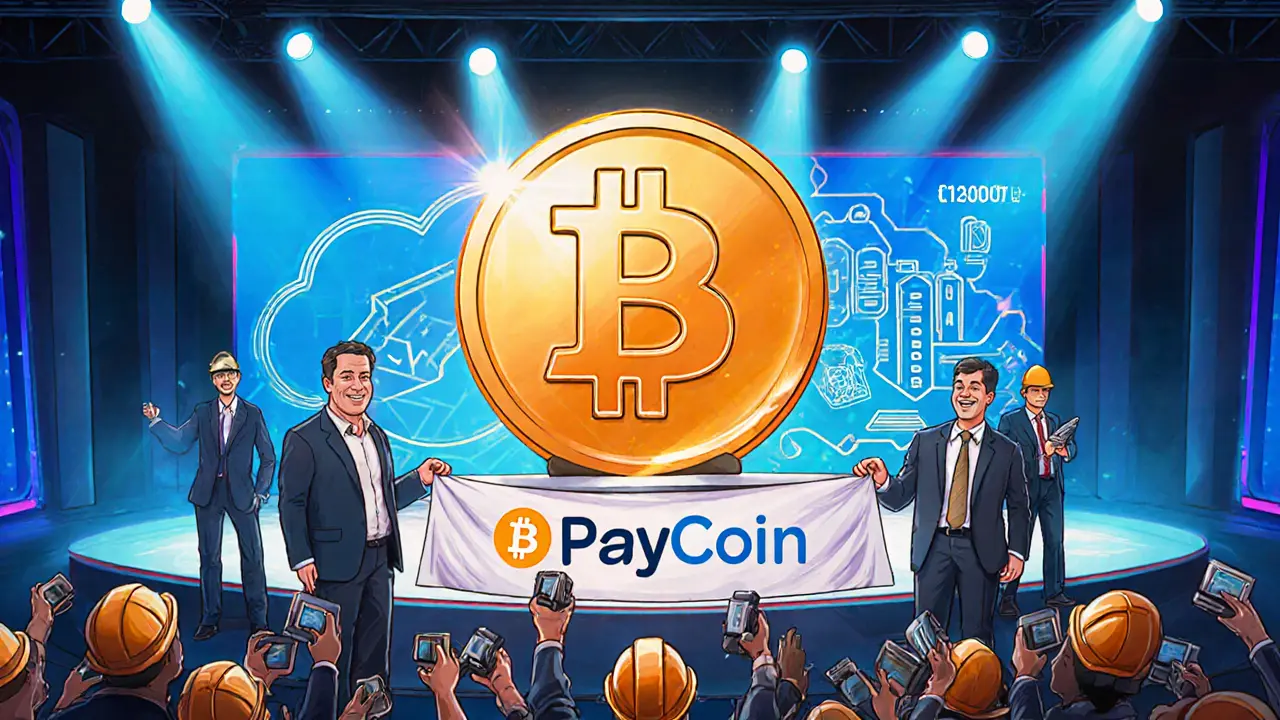
- 30 Apr 2025
- Elara Crowthorne
- 24
PayCoin (XPY) Value Calculator
About PayCoin (XPY)
PayCoin (XPY) was launched in 2014 as a Bitcoin fork. It collapsed after fraud allegations, leaving the token nearly worthless. This calculator helps estimate the value of your holdings based on historical data.
Your PayCoin Investment Value
Current Price per XPY:
Total Value:
Peak Price (2014):
Loss Since Peak:
Quick Takeaways
- PayCoin (XPY) was launched in 2014 as a Bitcoin fork backed by GAWMiners.
- It uses the SHA‑256 algorithm and a hybrid PoW/PoS consensus.
- The project collapsed after the founders were prosecuted for fraud, leaving the token nearly worthless.
- Peak price: $12.75 in 2014; current price: around $0.00114.
- Today it exists only as a cautionary case study, not a usable payment network.
What is PayCoin (XPY)?
When you see the name PayCoin (XPY) is a decentralized, open‑source cryptocurrency created as a fork of Bitcoin, the first thought is often “another altcoin”. In reality, PayCoin was built to power the PayBase a cryptocurrency payment‑processing platform that never fully launched. The idea was to bridge traditional payment rails with crypto, but the promised ecosystem never materialised.
Technical Foundations
PayCoin inherits Bitcoin’s core code, meaning it runs on the SHA‑256 a cryptographic hash function used to secure the blockchain algorithm. Where it tries to differ is the consensus model. PayCoin introduced a hybrid PoW/PoS a mix of proof‑of‑work and proof‑of‑stake to achieve block finality. Early miners could still use standard ASICs, but token holders later gained the ability to stake their XPY and earn rewards without additional hardware.
Key technical attributes:
- Total supply: 11,995,342 XPY (no hard cap beyond the initial issuance).
- Algorithm: SHA‑256 (compatible with Bitcoin mining equipment).
- Consensus: Initially 100% PoW, transitioned to a hybrid PoW/PoS model.
- Wallet: A dedicated PayCoin client was released, but it fell out of support after the collapse.
History and Development
The story starts on December 12, 2014, when the founders of GAWMiners a cloud‑mining operation that marketed itself as a turnkey way to earn Bitcoin announced PayCoin. Their pitch was simple: investors would buy XPY, stake or mine it, and use the resulting tokens on the upcoming PayBase platform to pay for goods online.
Unlike many projects of that era, PayCoin never held a public ICO. Instead, it relied on the existing GAWMiners user base to fund the token sale. The marketing material promised faster, cheaper transactions than Bitcoin and a direct gateway for merchants. By early 2015, the token had reached an all‑time high of $12.75, driven largely by hype and the reputation of GAWMiners. However, the promised PayBase marketplace never launched. As the months passed, investors began to notice missing updates, delayed payouts, and a growing lack of transparency.
Market Performance - From Boom to Bust
At its peak, PayCoin’s market cap briefly hovered around $150million, placing it inside the top‑200 cryptos by value. Today, the situation is starkly different:
- Current price: ~$0.00114 per XPY.
- Market cap: roughly $13,800.
- 24‑hour trading volume: virtually $0 (ranked #11,292 in volume).
- Listed on only one small exchange, with near‑zero liquidity.
The token has shed 99.99% of its value, making it a textbook example of a crypto bubble burst. The modest 115% year‑over‑year price increase shown in some charts is misleading-it reflects movement from an almost zero base, not genuine growth.
Legal Trouble and the Fraud Verdict
The turning point came when U.S. authorities opened a criminal investigation into GAWMiners. In 2017, the CEO was sentenced to 21months in prison and ordered to repay $9.2million in restitution to defrauded investors. The court found that the entire PayCoin scheme was built on false promises and that the company never intended to deliver a functional PayBase platform.
These legal outcomes cemented PayCoin’s reputation as one of the most notorious crypto frauds. Academic papers and regulatory guidelines frequently cite the case when discussing investor protection and the perils of unregulated ICO‑style fundraising.

Why PayCoin Failed - Lessons Learned
Technical competence alone wasn’t enough. The project stumbled for several intertwined reasons:
- Empty business model: No real merchant adoption, no revenue‑generating service.
- Poor governance: The team operated in secrecy, ignoring community feedback.
- Fraudulent marketing: Promises of high returns and a ready‑made payment ecosystem proved false.
- Lack of development: After the initial launch, code updates ceased, and the wallet became obsolete.
- Regulatory crackdown: Legal action against GAWMiners crippled any remaining trust.
When you combine these factors, even a solid SHA‑256 implementation can’t save the token.
How to Spot Similar Scams
If you’re considering a new coin, keep these red flags in mind:
- Absence of a transparent whitepaper or clear technical roadmap.
- Heavy reliance on a single company’s reputation rather than an open community.
- Promises of instant merchant integration without demo or pilot programs.
- Unrealistic price targets and “guaranteed returns” in marketing copy.
- Lack of third‑party audits or code reviews on public repositories.
Applying these checks can help you avoid another PayCoin‑style loss.
PayCoin vs. Bitcoin - A Quick Comparison
| Feature | PayCoin (XPY) | Bitcoin (BTC) |
|---|---|---|
| Launch Year | 2014 | 2009 |
| Consensus | Hybrid PoW/PoS | Pure PoW |
| Algorithm | SHA‑256 | SHA‑256 |
| Total Supply | 11,995,342 XPY (no hard cap) | 21,000,000 BTC |
| Main Use‑Case | Payment processing on PayBase (never launched) | Store of value & peer‑to‑peer payments |
| Current Market Cap | ~$13,800 | ≈$560billion (2025) |
| Regulatory Status | Associated with fraud conviction | Globally recognized, regulated in many jurisdictions |
Frequently Asked Questions
Is PayCoin still tradable?
Only one small exchange lists XPY, and liquidity is practically zero. Most traders treat it as a dead coin.
Can I still stake PayCoin?
Technically the code still supports staking, but without active validators or a network of users, staking rewards are negligible.
What happened to the PayBase platform?
PayBase never launched. The development team shut down after legal action against GAWMiners, leaving the platform incomplete.
Is PayCoin a scam?
Court findings confirmed fraudulent conduct by the founders. While the token’s code isn’t malicious, the project was used to defraud investors.
Should I invest in PayCoin now?
Given the near‑zero liquidity, lack of development, and legal history, investing in XPY is not advisable.



24 Comments
PayCoin looks like another one of those sketchy crypto scams that pop up and disappear. The whole thing feels like a nightmare waiting to happen.
That peak price was insane, but the current value is basically zero. Looks like a cautionary tale.
From a technical standpoint, XPY used the SHA‑256 hash, identical to Bitcoin, and later introduced a hybrid PoW/PoS consensus. The architecture was sound on paper, but the lack of network activity nullified any real utility. Without validators, staking rewards are purely theoretical.
Ah, the tragic ballet of ambition and deception, a tale as old as the internet itself-PayCoin, a phoenix that never learned to rise; it could have been a marvel, yet it floundered, sank, and became a cautionary footnote, reminding us that not all that glitters is gold, especially in the cryptoverse.
The numbers speak for themselves; almost all value gone. It's a textbook example of a failed venture.
Oh sure, invest in a coin that’s basically a digital paperweight. Nothing says "smart money" like dumping your cash into a dead project.
i feel for those folks who lost money, its really sad. maybe next time they do more research before jumping in.
PayCoin (XPY) provides a stark illustration of why rigorous due‑diligence is indispensable when evaluating cryptocurrency projects. Firstly, the token’s genesis was tied to GAWMiners, a cloud‑mining operation whose primary business model was already under scrutiny for lack of transparency. Secondly, the promised PayBase platform never materialised, leaving XPY without a functional use‑case or merchant adoption. Thirdly, the hybrid PoW/PoS consensus, while theoretically appealing, was never deployed at scale, rendering staking mechanisms inert. Fourth, the legal entanglement culminating in a criminal conviction of the founders introduced an irreversible trust deficit among investors. Fifth, the token’s liquidity evaporated, as evidenced by a single exchange listing with near‑zero trading volume. Sixth, the token’s supply dynamics-approximately twelve million XPY with no hard cap-offered no scarcity incentive. Seventh, the codebase, though derived from Bitcoin, saw no meaningful updates after 2015, causing it to fall behind security best practices. Eighth, community engagement was negligible; forums and social channels went silent shortly after the scandal broke. Ninth, the market’s reaction-a 99.99% loss-from a $12.75 peak to a $0.00114 trough, underscores the catastrophic depreciation. Tenth, the broader lesson is that cryptographic soundness alone does not guarantee project viability; governance, transparent roadmaps, and regulatory compliance are equally critical. Eleventh, prospective investors should always verify the existence of a working product, not merely a whitepaper. Twelfth, scrutinising the backgrounds of the founding team can reveal red flags, such as prior involvement in dubious schemes. Thirteenth, monitoring legal developments can provide early warnings of potential fraud. Fourteenth, diversifying across multiple vetted assets mitigates exposure to “pump‑and‑dump” scenarios. Finally, treating any crypto investment with the same caution one would apply to traditional securities can save considerable financial and emotional distress.
Even with its disastrous history, PayCoin reminds us that innovation often walks hand‑in‑hand with experimentation. There's a silver lining: the community can learn from these missteps and build more resilient frameworks.
The article breaks down the timeline well; it’s helpful to see how quickly things unraveled. Understanding these cues can help protect future investors.
LOOK AT THIS DISASTER! IF WE KEEP SUPPORTING THESE SCAMS, WE’RE JUST MAKING THE SAME MISTAKE OVER AND OVER AGAIN! WE NEED TO STOP THIS NOW.
Well, everybody says it was a fraud, but maybe the market just didn’t understand the vision. I still think the idea had some merit.
Honestly, watching XPY crash is like watching a tragic movie that you can’t stop watching. 🙄
Technical failure combined with regulatory crackdown sealed PayCoin’s fate.
It’s crazy how quickly the whole thing fell apart-felt like a house of cards.
Such a vivid reminder: hype without substance leads nowhere; the crypto space needs more accountability.
The comparison table highlights the stark contrast between Bitcoin’s robustness and PayCoin’s fragility.
Even if it’s dead, the lessons are alive. Let’s keep sharing knowledge.
PayCoin’s story is a drama in every sense-rise, fall, and a cautionary ending.
Avoid it.
Looks like a classic case of overpromising and underdelivering. Classic crypto hustle.
People need to stop glorifying failed projects. It’s irresponsible and harmful.
While some might suggest “just a lesson learned,” it’s more than that; it’s a stark warning against blind trust in unverified ventures.
Sharing these insights helps the community stay vigilant. Let’s continue to discuss and educate.